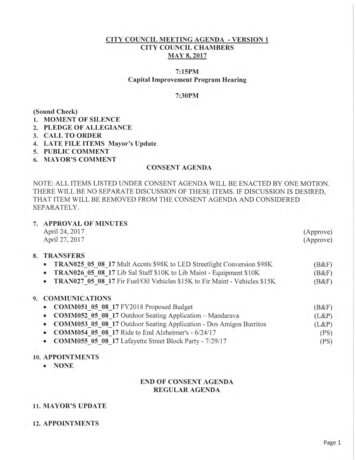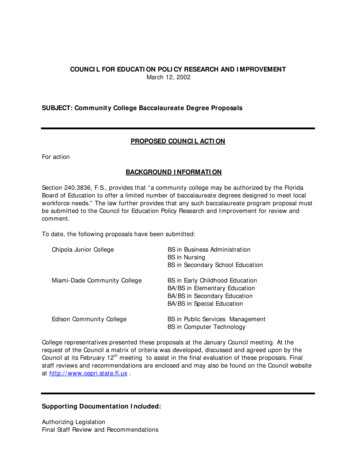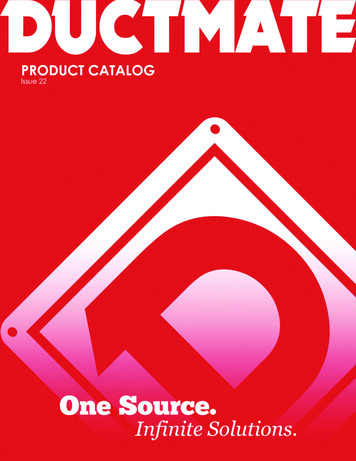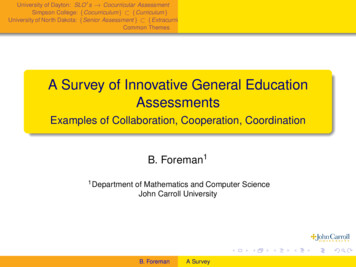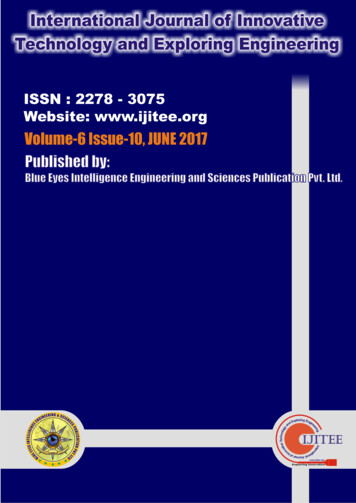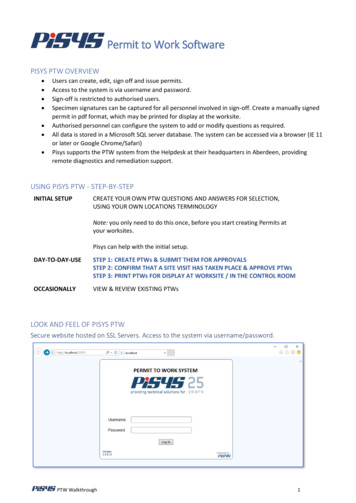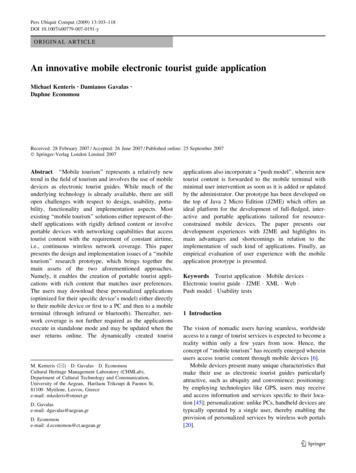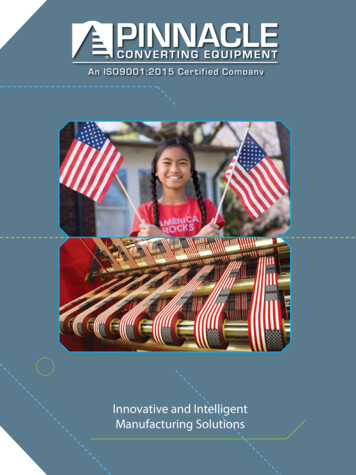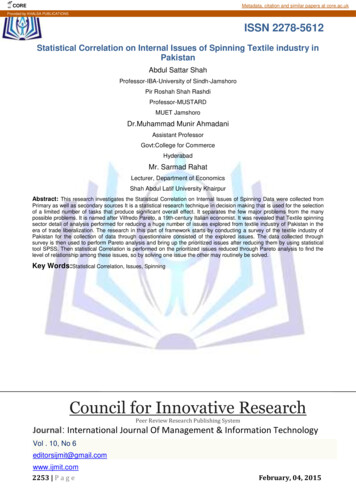
Transcription
COREMetadata, citation and similar papers at core.ac.ukProvided by KHALSA PUBLICATIONSISSN 2278-5612Statistical Correlation on Internal Issues of Spinning Textile industry inPakistanAbdul Sattar ShahProfessor-IBA-University of Sindh-JamshoroPir Roshah Shah RashdiProfessor-MUSTARDMUET JamshoroDr.Muhammad Munir AhmadaniAssistant ProfessorGovt:College for CommerceHyderabadMr. Sarmad RahatLecturer, Department of EconomicsShah Abdul Latif University KhairpurAbstract: This research investigates the Statistical Correlation on Internal Issues of Spinning Data were collected fromPrimary as well as secondary sources It is a statistical research technique in decision making that is used for the selectionof a limited number of tasks that produce significant overall effect. It separates the few major problems from the manypossible problems. It is named after Vilfredo Pareto, a 19th-century Italian economist. It was revealed that Textile spinningsector detail of analysis performed for reducing a huge number of issues explored from textile industry of Pakistan in theera of trade liberalization. The research in this part of framework starts by conducting a survey of the textile industry ofPakistan for the collection of data through questionnaire consisted of the explored issues. The data collected throughsurvey is then used to perform Pareto analysis and bring up the prioritized issues after reducing them by using statisticaltool SPSS. Then statistical Correlation is performed on the prioritized issues reduced through Pareto analysis to find thelevel of relationship among these issues, so by solving one issue the other may routinely be solved.Key Words:Statistical Correlation, Issues, SpinningCouncil for Innovative ResearchPeer Review Research Publishing SystemJournal: International Journal Of Management & Information TechnologyVol . 10, No 6editorsijmit@gmail.comwww.ijmit.com2253 P a g eFebruary, 04, 2015
ISSN 2278-5612IntroductionTextile industry of Pakistan is broadly divided into many sectors that are Ginning, Spinning, Weaving, Knitting, Towel,Dying, Printing, Processing, Hosiery, Made-ups and Garments. As the first objective was concerned with understandingthe current status of textile industry; in this connection a survey of the entire textile industry was conducted. A sample of100 respondents was designed for conducting the research in Hyderabad, Kotri, Karachi, Faisalabad and Lahore regionincluding the key integrated textile units to ensure full representation of all sectors. Further the above sectors of textileindustry were lumped together into four major sectors as Spinning, Weaving (including Knitting), Processing (including;Dying Printing & Bleaching), and Garments (including Made-ups, towel, Hosiery and other manufactured items) forcompiling the qualitative information. The survey methodology included a combination of primary data that was generatedthrough a questionnaire and intensive interviews with individuals connected to the industry to identify their internal issues,national issues, global issues and required remedial actions and the secondary data included journal articles, tradepolicies of Pakistan, news, and internet which were helpful for the second and the third objectives. For theaccomplishment of second objective the graphs are used to explain the growth pattern of textile exports from the year1980 to 2009 as the implementation of WTO on textile industry of Pakistan started from 1995 that was 100% complete in2005. Therefore the starting 14 years from 1980 to 1994 are considered as the time period with quotas, whereas the last14 years from 1995 to 2009 are considered as the quota free era. In the third objective developing countries like China,India, Srilanka and Bangladesh are taken into account to analyze the effects of WTO on them. Here the informationcollected through the above mentioned secondary sources regarding the benefits of becoming the member of WTO andthe problems associated with its implementation are highlighted.Textile spinning sector detail of analysis performed for reducing a huge number of issues explored from textile industry ofPakistan in the era of trade liberalization. The research in this part of framework starts by conducting a survey of the textileindustry of Pakistan for the collection of data through questionnaire consisted of the explored issues. The data collectedthrough survey is then used to perform Pareto analysis and bring up the prioritized issues after reducing them by usingstatistical tool SPSS. Then statistical Correlation is performed on the prioritized issues reduced through Pareto analysis tofind the level of relationship among these issues, so by solving one issue the other may routinely be solved.The detail of the analysis performed to reduce and resolve the explored issues from the textile industry of Pakistan isdiscussed in the following sections:Issues of Textile industry of PakistanThe issues of textile industry of Pakistan as shown in figure 6-1 are divided into three categories: Internal Issues National Issues Global IssuesFigure 6-1 Issues of Textile industry of Pakistan6.2.1 Internal IssuesThe internal issues of the textile industry of Pakistan as shown in figure 6-3 are divided sector wise into four sectors: Issues of spinning Issues of weaving Issues of processing2254 P a g eFebruary, 04, 2015
ISSN 2278-5612 Issues of GarmentFigure 6-2 Internal Issues of Textile Industry of Pakistan6.2.1-1 Internal Issues of the Spinning SectorInitially there were about 7 issues in the Spinning Sector that are also presented in figure 6-3 below:1 CC: Contaminated cotton is used in spinning2 LQ: Low quality of yarn3 IS: It is difficult to meet the International Standards4 LR: Lower returns from selling yarn in International Markets5 SH: Agriculturists are shifting from cotton to other cash crops6 HM: Improper handling methods of cotton7 CA Unable to benefit from the competitive advantageFigure 6-3: Issues of Spinning Sector6.2.1-2 Pareto Analysis on the issues of Spinning SectorPareto Analysis was performed on the issues of spinning sector by using SPSS and the output is shown in Pareto chart 61 below:2255 P a g eFebruary, 04, 2015
ISSN 2278-5612Pareto Chart 6- 1: Pareto Analysis on the issues of Spinning Sector6.2.1-3 Result of Pareto Analysis on the issues of Spinning SectorInitially as the issues of Spinning Sector were 7, after performing Pareto analysis the output shows total counts equivalentto 1031. As the Pareto analysis is a technique used in decision making to highlight the prioritized issues, so that by solvingthem overall problems (about 80%) may be solved. In this connection it is suggested to take about 80% to solve theoverall issues but here the 80% is between fifth and issue. Therefore it was decided to take about 76% through which 5issues may be selected as shown in the Diagram 6-1 and also shown the remaining 5 issues in figure: 6-4 below forfurther making decisions. However 6 issues were equal to 927 which were about 90%. Total (Counts): Suggested:824 (80%) Taken (5 Issues):792 (76.81%)1031 (100%)Pareto Chart 6-2: Selection from Pareto Chart2256 P a g eFebruary, 04, 2015
ISSN 2278-5612Therefore, 5 issues are selected from spinning sector that are also presented in figure 6-5 below:1 CC: Contaminated cotton is used in spinning2 LQ: Low quality of yarn3 LR: Lower returns from selling yarn in International Markets4 HM: Improper handling methods of cotton5 CA: Unable to benefit from the competitive advantageselected issues of spinning sector after Pareto analysisConclusion: To solve the problems associated with textile industry that is experiencing a decline in exports country’sGovernment plays an important role. In case of industrial problems associated with trade, Government attempts to solvethe issues through trade policy measures. The second body to solve the issues is industry that by making innovativedecisions and through developing strategies may provide the means to resolve them. Finally, the university may furtherattempt the researchers to conduct research for the prosperity of industry and economic development of Pakistan byproviding appropriate ways to solve the issues.1.Rafi K. S., 2005, “ Impact of WTO on the Patterns of Trade in Textile & Clothing”, Journal of Management andSocial Sciences, Vol. 1, No. 2, (Autumn 2005) 204-2262.Sasi A, 2005, “Asian Textile Nations to Join Hands to Rule Global Markets”, Business Line, International Edition,Financial Daily from the Hindu Group of Publications Sunday, Sep. 4, 2005.3.Sheikh H, 2005, ”Pakistan bed linen exports: Problems & Prospects “, Pakistan Textile Journal4.Viqar S, 2005, ” Brand Development and the Role of Designers in WTO ”, Pakistan Textile Journal5.Weeraratne B, 2005,”Labour Standards and International Trade : The Case of EU GSP Concessions to Srilanka”,Working Paper Series No: 8.6.Kashif R. S, 2005, “Impact of WTO on the Patterns of Trade in Textile & Clothing”, Journal of Management andSocial Sciences, Vol. 1, No. 2, (Autumn 2005) 204-2267.Baig M, 2004, “Global scenario of textiles and position of Pakistan “, Pakistan Textile Journal.8.Haverson K, 2004, “China’s WTO accession: Economic, Legal and Political(Publication Students Homepage).9.Kelegama, S., 2004, “Ready-Made Garment Industry in Sri Lanka: Facing the Global Challenge”, Institute ofPolicy Studies, Colombo.10. Council Regulation (EC) No 980/2005 of 27 June 2005, “Applying a scheme ofOfficial Journal L 169, 30/06/2005 P. 0001 – 0043.2257 P a g eImplications”, Journal Contents,generalised tariff preferences”,February, 04, 2015
ISSN 2278-561211. MTDF (Medium term development Framework 2005 – 10) Planning Commission Government of Pakistan, May2005.12. United States International Trade Commission (USITC) 2004, Textile and Apparel: Assessment of theCompetitiveness of Certain Foreign Suppliers to the U.S. Market, Vol. 1, USITC, Washington, D.C.13. RIS (2004). South Asia Development and Cooperation Report 2004, Research and Information System for NonAligned and Other Developing Countries, New Delhi.14. UNCTAD (2003), “The tiesAct:APreliminaryassessment”,15. IPS (2003), Sri Lanka: State of the Economy – 2003, Institute of Policy Studies, Colombo, Sri Lanka.2258 P a g eFebruary, 04, 2015
Pareto Analysis was performed on the issues of spinning sector by using SPSS and the output is shown in Pareto chart 6-1 below: ISSN 2278-5612 2256 P a g e February, 04, 2015 Pareto Chart 6- 1: Pareto Analysis on the issues of Spinning Sector 6.2.1-3 Result of Pareto Analysis on the
